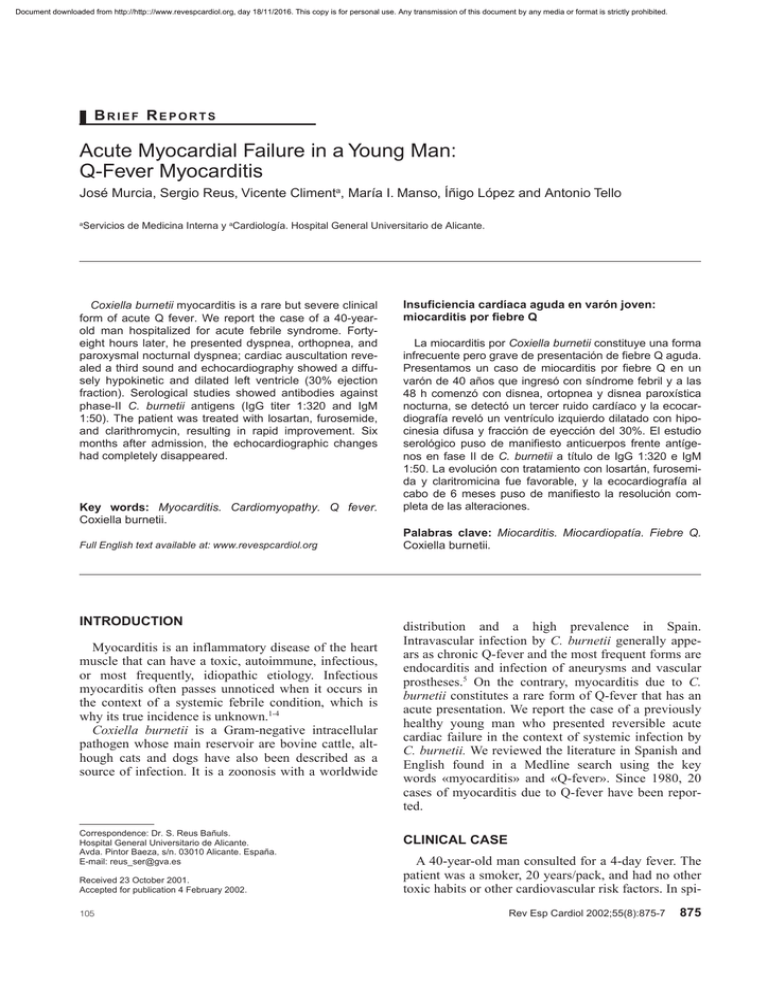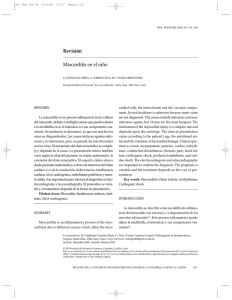Acute Myocardial Failure in a Young Man: Q
Anuncio

Document downloaded from http://http:://www.revespcardiol.org, day 18/11/2016. This copy is for personal use. Any transmission of this document by any media or format is strictly prohibited. BRIEF REPORTS Acute Myocardial Failure in a Young Man: Q-Fever Myocarditis José Murcia, Sergio Reus, Vicente Climenta, María I. Manso, Íñigo López and Antonio Tello a Servicios de Medicina Interna y aCardiología. Hospital General Universitario de Alicante. Coxiella burnetii myocarditis is a rare but severe clinical form of acute Q fever. We report the case of a 40-yearold man hospitalized for acute febrile syndrome. Fortyeight hours later, he presented dyspnea, orthopnea, and paroxysmal nocturnal dyspnea; cardiac auscultation revealed a third sound and echocardiography showed a diffusely hypokinetic and dilated left ventricle (30% ejection fraction). Serological studies showed antibodies against phase-II C. burnetii antigens (IgG titer 1:320 and IgM 1:50). The patient was treated with losartan, furosemide, and clarithromycin, resulting in rapid improvement. Six months after admission, the echocardiographic changes had completely disappeared. Key words: Myocarditis. Cardiomyopathy. Q fever. Coxiella burnetii. Full English text available at: www.revespcardiol.org INTRODUCTION Myocarditis is an inflammatory disease of the heart muscle that can have a toxic, autoimmune, infectious, or most frequently, idiopathic etiology. Infectious myocarditis often passes unnoticed when it occurs in the context of a systemic febrile condition, which is why its true incidence is unknown.1-4 Coxiella burnetii is a Gram-negative intracellular pathogen whose main reservoir are bovine cattle, although cats and dogs have also been described as a source of infection. It is a zoonosis with a worldwide Correspondence: Dr. S. Reus Bañuls. Hospital General Universitario de Alicante. Avda. Pintor Baeza, s/n. 03010 Alicante. España. E-mail: [email protected] Received 23 October 2001. Accepted for publication 4 February 2002. 105 Insuficiencia cardíaca aguda en varón joven: miocarditis por fiebre Q La miocarditis por Coxiella burnetii constituye una forma infrecuente pero grave de presentación de fiebre Q aguda. Presentamos un caso de miocarditis por fiebre Q en un varón de 40 años que ingresó con síndrome febril y a las 48 h comenzó con disnea, ortopnea y disnea paroxística nocturna, se detectó un tercer ruido cardíaco y la ecocardiografía reveló un ventrículo izquierdo dilatado con hipocinesia difusa y fracción de eyección del 30%. El estudio serológico puso de manifiesto anticuerpos frente antígenos en fase II de C. burnetii a título de IgG 1:320 e IgM 1:50. La evolución con tratamiento con losartán, furosemida y claritromicina fue favorable, y la ecocardiografía al cabo de 6 meses puso de manifiesto la resolución completa de las alteraciones. Palabras clave: Miocarditis. Miocardiopatía. Fiebre Q. Coxiella burnetii. distribution and a high prevalence in Spain. Intravascular infection by C. burnetii generally appears as chronic Q-fever and the most frequent forms are endocarditis and infection of aneurysms and vascular prostheses.5 On the contrary, myocarditis due to C. burnetii constitutes a rare form of Q-fever that has an acute presentation. We report the case of a previously healthy young man who presented reversible acute cardiac failure in the context of systemic infection by C. burnetii. We reviewed the literature in Spanish and English found in a Medline search using the key words «myocarditis» and «Q-fever». Since 1980, 20 cases of myocarditis due to Q-fever have been reported. CLINICAL CASE A 40-year-old man consulted for a 4-day fever. The patient was a smoker, 20 years/pack, and had no other toxic habits or other cardiovascular risk factors. In spiRev Esp Cardiol 2002;55(8):875-7 875 Document downloaded from http://http:://www.revespcardiol.org, day 18/11/2016. This copy is for personal use. Any transmission of this document by any media or format is strictly prohibited. Murcia J, et al. Acute Myocardial Failure in a Young Man: Q-Fever Myocarditis te of residing in an urban area, he kept parakeets and a rabbit. He had been hospitalized 15 years earlier for chest pain, which was diagnosed as acute idiopathic pericarditis. He did not have a history of effort dyspnea, orthopnea, nocturnal paroxysmal dyspnea, or peripheral edema. The patient consulted for a high fever of 4 days duration that exhibited no focality. The physical examination and chest radiograph at admission indicated no abnormality. Forty-eight hours later he began to experience dyspnea, nocturnal orthopnea, and paroxysmal dyspnea. In the physical examination, the intense deterioration of the patient´s general condition was notable, with a temperature of 39 °C, heart rate 110 beats/min, respiratory rate 32 breaths/min, cyanosis, blood pressure 100/60 mm Hg, ventricular gallop, and inspiratory crepitations in both lung bases. There was no jugular ingurgitation, liver enlargement, or edema. The laboratory findings were 8000 leukocytes/µL (83% polymorphonuclear), hemoglobin 16 g/dL, platelets 140 000/µL, glucose 100 mg/dL, creatinine 0.5 mg/dl, AST 57 U/L, ALT 58 U/L, GGT 62 U/L, AlP 156 U/L, LDH 850 U/L, CPK 55 U/L, ESR 12 mm Hg, PCR 11 mg/dL. Arterial gasometry with FiO2 21% disclosed pH 7.48, PpO2 57 mm Hg, and PpCO2 30 mm Hg. The ECG revealed sinus rhythm 114 beats/min with non-specific repolarization disorders. Cardiomegaly with bilateral interstitial edema was evident in the chest radiograph, with bilateral Kerley B lines and pleural effusion. Echocardiography revealed a dilated left ventricle with diffuse hypokinesia and an ejection fraction of 30%. Antibiotic treatment was begun with intravenous ceftriaxone and clarithromycin (for 14 days) as well as furosemide and losartan. The clinical evolution was favorable, with abatement of the fever in 48 h and amelioration of the symptoms of heart failure. Blood cultures were negative. Serological study by indirect immunofluorescence of a single sample revealed antibodies against phase II C. burnetii antigens at titers of 1/320 IgG and 1/50 IgM. The serology for HIV, enterovirus, adenovirus, herpesvirus, Mycoplasma pneumoniae, and Chlamydia psittaci was negative. In later studies the patient remained asymptomatic and had an active lifestyle, so pharmacological treatment was discontinued. The echocardiographic study made at 6 months showed a left ventricle of normal size with an ejection fraction of 60%. DISCUSSION Myocarditis of infectious origin is uncommon. Its exact incidence is not known since it is probable that mild conditions that course asymptomatically with non-specific electrocardiographic disturbances pass unnoticed.6,7 The diagnosis should be considered in 876 Rev Esp Cardiol 2002;55(8):875-7 any patient with a febrile syndrome and elevation of CK-MB, rhythm disorder, or symptoms of heart failure, as in our patient. This patient was a healthy adult with no history of heart failure disclosed in the interview and non-specific repolarization disorders and heart failure due to systolic dysfunction. No increase in CK was observed in serial, but this is common in myocarditis.3 It was initially thought that the patient had undiagnosed dilated cardiomyopathy who had become decompensated as a result of an intercurrent infectious process. However, the patient´s evolution demonstrated that he had acute cardiac failure since ventricular function normalized completely after 6 months. The diagnosis of myocarditis continues to be based on clinical, electrocardiographic, and analytical findings (CK) because endomyocardial biopsy is an invasive technique with potentially serious complications and a low sensitivity and specificity.2 In addition, its outcome often does not modify the therapeutic attitude. Most cases of myocarditis are idiopathic, although they are generally attributed to a viral infection that cannot be demonstrated.7,8 The diagnosis of acute Qfever usually is made by serology, either by demonstrating seroconversion, or, as in our patient, by the demonstration of antibodies against phase II C. burnetii antigen at IgG titers of 1:200 or more and/or IgM 1:50 or more in a single sample.9 The serology of Q-fever is specific and there are no cross-reactions with rickettsia or other microorganisms.10 The diagnosis of certainty can be made by cell cultures, but these are complex techniques that entail a risk of infection for the personnel that perform them10 and they are not performed in most centers. When we knew the result of serology, our patient was totally asymptomatic and had received 2 weeks of treatment with clarithromycin, which is effective against C. burnetii, which is why doxicycline, the drug of choice, was not administered. We do not know what influence antibiotic treatment administered in the acute phase of infection could have on the evolution of myocarditis. The available information on myocarditis due to C. burnetii is scant. We found only two series of cases, and in one of them11 the authors did not describe the clinical characteristics of the form of presentation. Fournier et al12 reported 8 cases of myocarditis in a series of 1276 patients with acute Q fever. Seven presented dilated cardiomyopathy, of which 6 evolved favorably and recovered cardiac function in the following months. In Spain, 3 cases have been described that were manifested by chest pain,13 ventricular fibrillation,14 and heart failure.15 All had a favorable outcome. The pathogenesis of myocarditis in humans is unknown, although there are animal models in which immunological mechanisms have been implicated.7 In the specific case of Q fever, information is even more scant, although the presence of C. burnetii in myocar106 Document downloaded from http://http:://www.revespcardiol.org, day 18/11/2016. This copy is for personal use. Any transmission of this document by any media or format is strictly prohibited. Murcia J, et al. Acute Myocardial Failure in a Young Man: Q-Fever Myocarditis dium has been demonstrated.16 In conclusion, C. burnetii is a microorganism that must be investigated in patients with febrile syndrome and myocarditis. Patients who develop heart failure have a high mortality, but they can recover completely. REFERENCES 1. Oakley CM. Myocarditis, pericarditis and other pericardial diseases. Heart 2000;84:449-54. 2. Drodison A, Swann JW. Myocarditis: a review. J Infect 1998;37: 99-103. 3. Pisani B, Taylor DO, Mason JW. Inflammatory Myocardial Diseases and Cardiomyopathies. Am J Med 1997;102:459-69. 4. Friman G, Wesslén L, Fohlamn J, Karjalainen J, Rolf C. The epidemiology of infectious myocarditis, lymphocytic myocarditis and dilated cardiomyopathy. Eur Heart J 1995;16:36-41. 5. Brouqui P, Tissot-Dupont H, Drancourt M, Berland Y, Etienne J, Leport C, et al. Chronic Q fever: ninety-two cases from France, including 27 cases without endocarditis. Arch Intern Med 1993;153:427-34. 6. D’Ambrosio A, Patti G, Manzoli A, Sinagra G, Di lenarda A, Silvestri F, et al. The fate of acute myocarditis between spontaneous improvement and evolution to dilated cardiomyopathy: a re- 107 view. Heart 2001;85:499-504. 7. Feldman AM, McNamara D. Myocarditis. N Engl J Med 2000; 343:1388-98. 8. Galve E, Alfonso F, Ballester M, Castro A, Fernández R, Penas M, et al. Guías de práctica clínica de la Sociedad Española de Cardiología en miocardiopatías y miocarditis. Rev Esp Cardiol 2000;53:360-93. 9. Fournier PE, Marrie TJ, Raoult D. Diagnosis of Q fever. J Clin Microbiol 1998;36:1823-34. 10. Marrie TJ. Coxiella burnetii (Q fever). En: Mandell, Douglas and Bennett’s. Principles and Practice of Infectious Diseases (5th ed.). Philadelphia: Churchill Livingstone, 2000; p. 2043-50. 11. Pebody RG, Wall PG, Ryan Mj, Fairley C. Epidemiological features of Coxiella burnetii infection in England and Wales: 1984 to 1994. Commun Dis Rep CDR Rev 1996;6:128-32. 12. Fournier PE, Etienne J, Harle JR, Habib G, Raoult D. Myocarditis, a rare but severe manifestation of Q fever: report of 8 cases and review of the literature. Clin Infect Dis 2001;32:1440-7. 13. Urrutia A, García J, Collazos J, de Miguel J. Miopericarditis aguda como presentación de fiebre Q. Med Clin (Barc) 1991;96:319. 14. Cuenca A, Rodríguez LM, Bilbao JM, Escolar JL. Arritmia grave en miocarditis por fiebre Q. Rev Clin Esp 1991;188:57. 15. Lozano de León F, Gea A, Gómez-Mateos JM, Grilo A. Miocarditis por fiebre Q. Med Clin (Barc) 1987;89:886. 16. Chevalier P, Vandenesch F, Brouqui P, Kirkorian G, Tabib A, Etienne J, et al. Fulminant myocardial failure in a previously healthy young man. Circulation 1997;95:1654-7. Rev Esp Cardiol 2002;55(8):875-7 877

